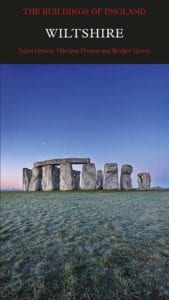

New Wiltshire Pevsner Guide features the St Mary’s polyptych on the back cover of the new edition.
A new edition of the Pevsner Guide to Wiltshire by Julian Orbach was published on 8th June. The ‘Pevsner’ series, founded by Sir Nikolaus Pevsner in 1951, is the unrivalled authority and source for the architecture of the British Isles. Churches and public buildings are covered in depth, alongside unusual and unpredictable structures such as folly towers, toll houses and railway viaducts. Castles and mansions are described in detail, along with a selection of lesser houses. Towns are explored in enjoyable perambulations, setting the streets and buildings in historical context. Contemporary architecture is included too, viewed with a critical but appreciative eye. Major themes are surveyed in a historical introduction, and there are full indexes for ease of use.Wiltshire was the ‘country of the cottage’ for Pevsner who kept a home at Clyffe Pypard and is buried in the churchyard there. His first edition, published in 1963, was updated and expanded in 1975 by Bridget Cherry. The new revision by Julian Orbach has added hundreds of buildings to the gazetteer and fully overhauled each of the descriptions. The third edition is now the most comprehensive, reliable and essential guide to Wiltshire’s architectural heritage from prehistory to the present day.
From the stone circles at Stonehenge and Avebury to railway age Swindon, Wiltshire encompasses every aspect of English building. Salisbury cathedral with its breathtaking spire is set in a spacious close with Georgian delights such as Mompesson House, within a planned medieval city. The towns include Marlborough with its sweeping High Street and Devizes with its wide market place. The villages include medieval Lacock, exceptionally preserved, at the gates of Lacock Abbey, remodelled as an eighteenth-century Gothick fantasy. The country houses include some of the finest: Elizabethan Longleat, Palladian Wilton, with which Inigo Jones was involved, Stourhead in its dream-like classical landscape, the elegant eighteenth-century Bowood and the mellow Bath stone of Corsham Court. Among the churches are the rare Anglo-Saxon chapel at Bradford-on-Avon, Malmesbury Abbey with its Romanesque sculpture, and Lydiard Tregoze with its tightly packed treasury of Elizabethan and Stuart monuments.
Among the discoveries made during research and fieldwork are: that the Anglo-Saxon church at Bradford on Avon may have been built around 1003 in expiation of the murder of King Edward the Martyr in 975, the murder having been organised by Edward’s step-mother, mother of Ethelred the Unready, who then took the throne; that Britain’s second largest prehistoric mound, after the famous Silbury Hill, has been hiding in plain sight at Marlborough College; that the clothier Abraham Laverton built Prospect Square in Westbury to house workers threatened with eviction for voting Tory in the 1869 election; that Ian Fleming’s Georgian-revival house at Sevenhampton was built in 1963 on the proceeds of the James Bond books; and that Salisbury House, Des Moines, Iowa of 1923-4 is not only a copy of the medieval to Elizabethan King’s House in The Close, Salisbury (now the Salisbury Museum) but contains fireplaces and staircase from various houses in Salisbury.
 THE BUILDINGS OF ENGLAND
THE BUILDINGS OF ENGLAND
WILTSHIRE
Julian Orbach, Nikolaus Pevsner and Bridget Cherry
Publication: 8 June 2021
984 pages, 250 x 250 mm, 118 colour and 76 b/w illustrations
£45 hardback / 9780300251203
Julian Orbach is author of the revised edition of Somerset: South and West (2014) and co-author of Pembrokeshire (2004), Carmarthenshire and Ceredigion (2006), and Gwynedd (2009) in The Buildings of Wales series.